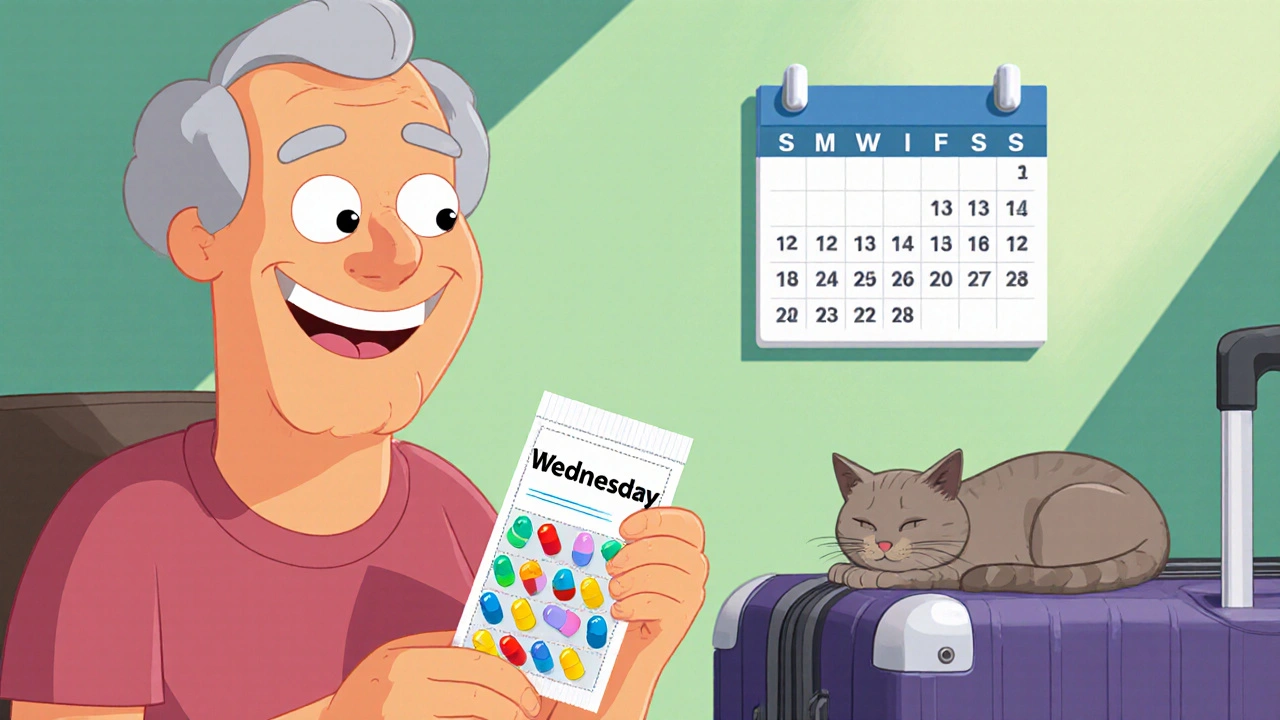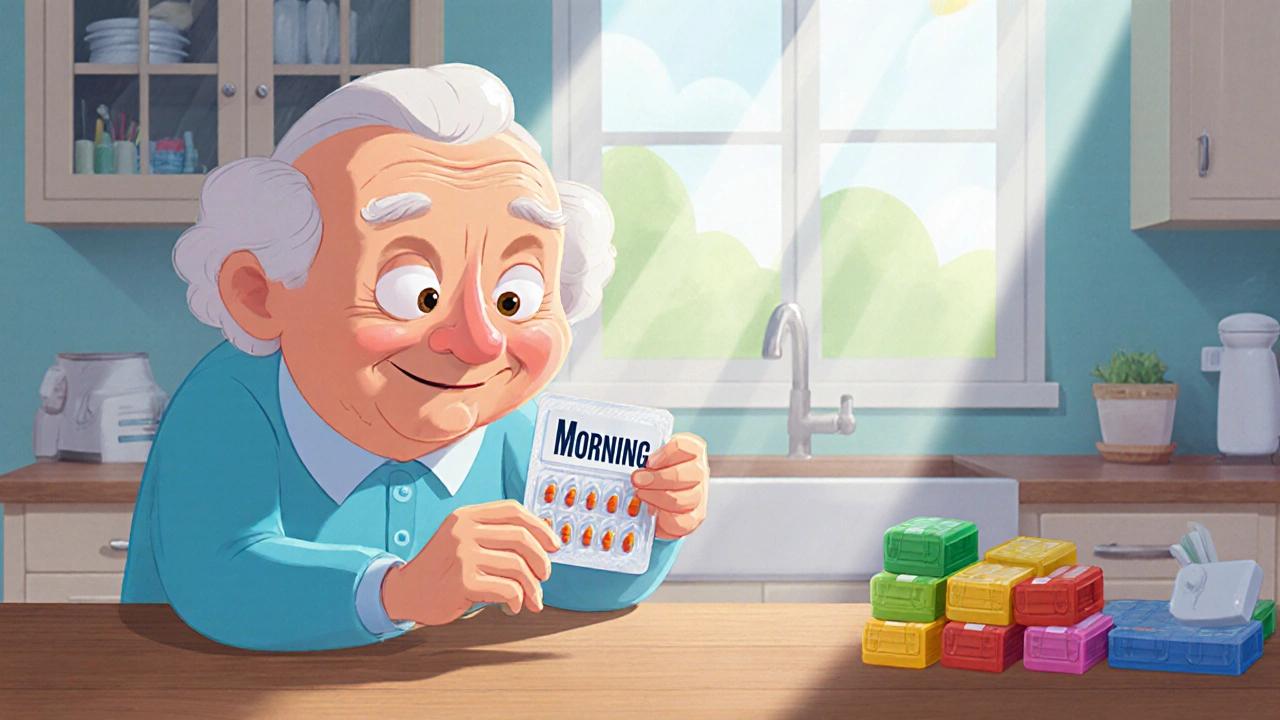Managing multiple medications every day is one of the biggest challenges for seniors. For many, it’s not just about remembering to take pills-it’s about taking the right pill, at the right time, every single day. Forgetfulness, poor eyesight, arthritis, and complex regimens make traditional pill bottles a recipe for mistakes. That’s where pill packs and blister packaging come in. These aren’t just convenient-they’re life-saving.
What Are Blister Packs and Pill Packs?
Blister packs and pill packs are pre-sorted medication systems made by pharmacies to help seniors take their medicines safely. Both are designed to remove guesswork. Instead of juggling several bottles, each dose is sealed in its own compartment, clearly labeled by day and time-morning, noon, evening, bedtime. Blister packs use a rigid plastic backing with foil seals. Each compartment holds one pill or capsule. To take the medication, you press firmly on the back of the compartment until the pill pushes through the foil. The foil stays intact if you haven’t taken it yet, so you can see at a glance what’s been missed. Pill packs, sometimes called bubble packs or multi-dose pouches, work similarly but are made of flexible, connected pouches. Each pouch holds one day’s worth of meds. You can tear off the pouch for the day and carry just that one with you when you travel. This makes pill packs better for short trips, while blister packs are ideal for home use.Why They Work Better Than Pill Bottles
Traditional pill bottles don’t help you track what you’ve taken. You might think you took your afternoon pill, but you’re not sure. Empty bottles don’t tell you if you missed a dose. Blister packs do. Here’s what changes when you switch:- Visual confirmation: If the foil is pushed through, you took it. If it’s still sealed, you didn’t. No guessing.
- Reduced errors: About 50% of medication mistakes happen at home. Blister packs cut that risk by organizing everything correctly from the start.
- Less spillage: Pills don’t roll out of a blister pack. PharmcareUSA found spill risks drop by 68% compared to bottles.
- Tamper evidence: Once you open a compartment, you can’t reseal it. This helps prevent accidental double-dosing or misuse.
- Bigger labels: Text is printed in high-contrast, large font. No more squinting at tiny print.
Who Benefits the Most?
These systems aren’t for everyone-but they’re perfect for seniors who:- Take five or more medications daily (nearly 4 in 10 seniors over 65 do)
- Have memory issues or dementia
- Struggle with arthritis or weak hands (nearly half of seniors do)
- Have vision problems
- Live alone and don’t have someone to remind them
How to Get Started
You don’t have to assemble these yourself. Pharmacists do all the work. Here’s the process:- Ask your pharmacist if they offer blister or pill packaging. Most do, especially in urban areas.
- Bring a full list of all your medications-including vitamins, supplements, and over-the-counter drugs.
- The pharmacist reviews your regimen for interactions and duplicates. This step alone reduces risky drug combinations by 37%, according to Home Instead Belfast.
- They sort each medication into the correct daily and time-specific compartments.
- You get your pack with clear labels and simple instructions: “Press firmly on the back to push the pill through.”

Blister Packs vs. Pill Packs: Which Is Right for You?
| Feature | Blister Pack | Pill Pack | |--------|--------------|-----------| | Structure | Rigid plastic with foil seals | Flexible, tear-off pouches | | Travel-Friendly | No-you must carry the whole week | Yes-you can take one day at a time | | Mid-Week Changes | Difficult-entire pack may need replacement | Easier-just swap the pouch | | Visibility of Missed Doses | Excellent-sealed foil shows untouched doses | Good-pouches remain unopened | | Best For | Home use, long-term stability | Frequent travelers, short-term needs | | Cost | Usually included in dispensing fee | Same as blister packs | If you travel often-even just to visit family for the weekend-pill packs give you more flexibility. If you’re mostly at home and want maximum safety, blister packs win.Cost and Insurance
In many places, there’s no extra charge. Pharmacies bundle the cost into standard dispensing fees. In Canada, Langford Pharmacy charges $4.99 per week. In the U.S., most pharmacies don’t bill separately. Medicare Part D increasingly covers this as part of Medication Therapy Management (MTM) services. Check with your plan. Even if it’s not covered, the cost is low compared to the price of a hospital visit caused by a missed or doubled dose.Limitations and Things to Watch For
No system is perfect. Here are the downsides:- Can’t change mid-week: If your doctor adds or removes a pill, you can’t just slip it in. The whole pack needs to be remade. That takes 3-5 business days. Plan ahead.
- Hard to open for some: About 28% of users in PharmcareUSA’s survey said pressing through the foil was tough with weak hands. If this is a problem, ask for a blister pack with easy-peel foil or consider pill packs instead.
- Not available everywhere: Only 62% of rural pharmacies offer this service, compared to 89% in cities. If you live remotely, call ahead.
- Refills require notice: You can’t just walk in and pick up a new pack. Schedule refills at least a week in advance.

What’s Next? Smart Blister Packs
The future is already here. Some new blister packs come with built-in sensors that track when you open each compartment. Data gets sent to a phone app or directly to your pharmacist or family caregiver. A 2023 study by Grand View Research predicts that by 2028, 45% of senior medication packaging will include digital monitoring. These aren’t just gadgets-they’re safety nets. If you miss a dose, someone gets an alert. Even without tech, the simple visual design of blister packs has already cut medication-related hospitalizations by 27% in care facilities, according to PharmcareUSA.Real Impact: More Than Just Convenience
This isn’t about making life easier. It’s about keeping seniors safe, independent, and out of the hospital. A 2021 study in the Annals of Internal Medicine found medication non-adherence costs the U.S. healthcare system $300 billion every year. Half of those cases involve seniors. Blister and pill packs don’t just reduce errors. They reduce fear. Seniors feel more in control. Families sleep better. Pharmacists can spot problems earlier. As one pharmacist put it: “Effective medication packaging isn’t about convenience. It’s about safety.”Final Thoughts
If you or a loved one is juggling multiple pills, it’s time to consider switching. Blister packs and pill packs turn a confusing, stressful chore into a simple, visual routine. They don’t fix memory loss or arthritis. But they give you a system that works around those challenges. Talk to your pharmacist today. Ask if they offer packaging. Bring your medication list. Ask about the differences between blister and pill packs. And don’t wait until a mistake happens. The goal isn’t just to take your pills. It’s to take them right-every time.Can I make my own pill pack at home?
It’s not recommended. Homemade pill organizers don’t include pharmacist review, so you risk dangerous drug interactions. They also don’t have tamper-proof seals or large-print labels designed for seniors. Pharmacies use clinical-grade systems that are tested for safety and clarity. DIY solutions may seem cheaper, but they increase the risk of errors.
Do blister packs work for seniors with arthritis?
Some seniors with arthritis find blister packs easier to use than traditional bottles because they don’t require twisting caps. But pressing through the foil can be hard if hand strength is very low. Ask your pharmacist about easy-peel foil options or consider pill packs, which use tear-off pouches instead. Many pharmacies offer both types to match individual needs.
How far in advance do I need to order a refill?
Most pharmacies need 3 to 5 business days to prepare a new blister or pill pack. This gives them time to review your medications, sort each dose, and verify everything is correct. Don’t wait until you’re out-schedule your refill at least a week before you run out.
Are blister packs covered by Medicare?
Many Medicare Part D plans now cover blister or pill packaging as part of Medication Therapy Management (MTM) services, especially for seniors on five or more medications. Coverage varies by plan, so call your insurer or ask your pharmacist to check your benefits. Even if not fully covered, the cost is often low or included in dispensing fees.
Can I travel with a blister pack?
You can, but it’s not ideal. Blister packs are designed as one-week units, so you’d need to carry the whole thing-even if you’re only gone for a day. Pill packs are better for travel because you can tear off just the daily pouch. If you travel often, ask your pharmacist for pill packs instead.
What if my medication changes?
If your doctor adds, removes, or changes a dose, your pharmacist will need to make a new pack. You can’t just slip a new pill into a sealed compartment. This takes 3-5 days, so plan ahead. Always tell your pharmacist about any changes-even small ones like a new vitamin or OTC painkiller.
Do these systems reduce hospital visits?
Yes. Facilities that use blister packaging report 27% fewer medication-related hospitalizations. When seniors take the right dose at the right time, they avoid complications like falls, confusion, or organ damage from wrong dosages. Better adherence means fewer ER trips and lower long-term costs.
Are smart blister packs worth it?
If you or your loved one has memory issues or lives alone, yes. Smart packs track when doses are taken and can alert caregivers if a pill is missed. They’re not necessary for everyone, but for those at high risk of non-adherence, they add a layer of safety that’s hard to replace. The technology is becoming more common and affordable.


Gerald Cheruiyot
November 20, 2025 AT 03:35Just had my grandma switch to blister packs last month. She used to call me three times a day asking if she took her blood pressure pill. Now she just points at the foil and says, 'See? Already done.' No more panic. No more guilt. Just peace.
Best $0 I ever spent.
Michael Fessler
November 20, 2025 AT 13:56From a clinical pharmacy standpoint, these systems are classified as Medication Adherence Interventions (MAIs) with Level 1 evidence in geriatric populations. The reduction in polypharmacy errors correlates strongly with decreased hospital readmissions-especially when combined with MTM protocols. The foil-seal mechanism acts as a binary compliance tracker, eliminating subjective recall bias. Pharmacies that integrate this into their dispensing workflow see a 37% drop in medication-related adverse events. It’s not just convenience-it’s pharmacoeconomic risk mitigation.
Alyssa Torres
November 21, 2025 AT 07:13OH MY GOSH. My mom used to dump all her pills into a Tupperware container. I found 17 different pills in there last week-including her cat’s flea medicine. She swore she ‘just needed to keep them together.’
After we got her a blister pack? She cried. Not because she was sad-because she finally felt like she could DO it herself. No one had to remind her. No one had to check. She looked at that pack like it was magic.
Thank you for writing this. I’m sharing it with every family member I know.
Aruna Urban Planner
November 23, 2025 AT 00:26Interesting how this mirrors the concept of ‘cognitive offloading’ in human-computer interaction. The externalized memory system reduces executive load-especially critical in aging brains where working memory capacity declines. The foil seal acts as a visual cue that triggers procedural memory, bypassing the need for conscious recall. The real innovation isn’t the packaging-it’s the design psychology behind it. Simple, silent, effective.
Why isn’t this standard in every pharmacy?
Nicole Ziegler
November 24, 2025 AT 08:31My aunt uses these and she’s 92. She doesn’t even know what a blister pack is called. She just calls it ‘the magic box.’ 🤍
Bharat Alasandi
November 25, 2025 AT 11:21Man, I been telling my pops for years to get one of these. He’s got 8 meds, arthritis hands, and still uses the original bottles. Says ‘it’s fine.’ Last week he took his blood thinner twice. Ended up in the ER. Now he’s got a blister pack. Still complains about the foil being too hard to push through. Gonna get him the easy-peel version next week.
Worth every penny.
Kristi Bennardo
November 26, 2025 AT 12:41This is a dangerous oversimplification. Pharmacies are pushing these systems because they shift liability away from doctors and onto patients. Who verifies the accuracy of the sorting? Who ensures the pharmacist didn’t misread a handwritten script? You think this is ‘life-saving’? It’s a Band-Aid on a broken system. The real problem is fragmented care, not packaging. And don’t get me started on how these packs are sometimes filled by interns with zero clinical training.
Shiv Karan Singh
November 27, 2025 AT 22:26Blister packs? More like government-controlled compliance tools. Next thing you know, they’ll be embedding trackers in them. Big Pharma + Medicare + Big Pharmacy = surveillance masquerading as care. My uncle got one and now his ‘care team’ gets alerts every time he opens a compartment. Sounds like a prison. You’re being monitored. You’re not being helped.
Ravi boy
November 29, 2025 AT 17:22My dad in Delhi uses these and they dont even have them here. He got his from a private clinic that imports from the US. Took 3 weeks. But now he takes his meds without me yelling. He says the big letters help. Also the foil thing is hard but he uses a spoon. Works fine.
Why dont they make these cheaper in India? Everyone needs this here.
Matthew Karrs
December 1, 2025 AT 06:15Let me guess-this is sponsored by PharmcareUSA. You think people don’t see this? Every ‘life-saving’ gadget for seniors is just another way to extract money from Medicare. The real cost? The $300 billion you mention? That’s from misprescribing, not mis-taking. And the ‘tamper evidence’? That’s just so they can say ‘you opened it’ if something goes wrong. This isn’t safety-it’s legal protection dressed up as kindness.
Matthew Peters
December 2, 2025 AT 10:25My sister’s best friend’s mom started using pill packs after her stroke. She used to forget everything-except she remembered to open the pouch. Like a ritual. She’d hold it up to the light, read the label, then tear it open like it was a gift. That’s the real win-not the foil, not the labels-but the dignity it gave her. She felt like she was still in control.
That’s worth more than any study.
Liam Strachan
December 3, 2025 AT 16:41Just spoke to my pharmacist yesterday about this. They offer blister packs for free if you’re on more than five meds. No extra charge. I didn’t even know that. Took me 10 minutes to set it up. My mum’s been using it for two weeks now. She says she feels ‘lighter’-like a weight’s been lifted. Simple things, right? But they matter.
daniel lopez
December 3, 2025 AT 20:32So you’re telling me we’re encouraging seniors to rely on plastic boxes instead of teaching them responsibility? This is infantilization. My grandfather took his meds for 40 years without a ‘pack.’ He used a watch and a notebook. Now we’ve turned old people into passive consumers of corporate-designed ‘solutions.’ What’s next? Medication vending machines with voice prompts? We’re losing something fundamental here.
Nosipho Mbambo
December 3, 2025 AT 21:05...I just... I don't know. I mean, I get it, but... I think... maybe... it's just too much? Like, why do we need all these compartments? Why not just... a pillbox? With like... four slots? Morning, afternoon, night, and... emergency? And... maybe... a timer? But... not too loud? Because my aunt says the alarms scare her? And... also... what if the foil tears? And... I'm just... confused? Like... is this really necessary? I mean... I'm not saying it's bad... I'm just... asking?
Gerald Cheruiyot
December 5, 2025 AT 10:28My grandma’s pharmacist now calls her every Friday to check if the pack worked. She says it’s ‘like having a friend who remembers.’ That’s the real magic. Not the foil. Not the labels. The human connection behind it.